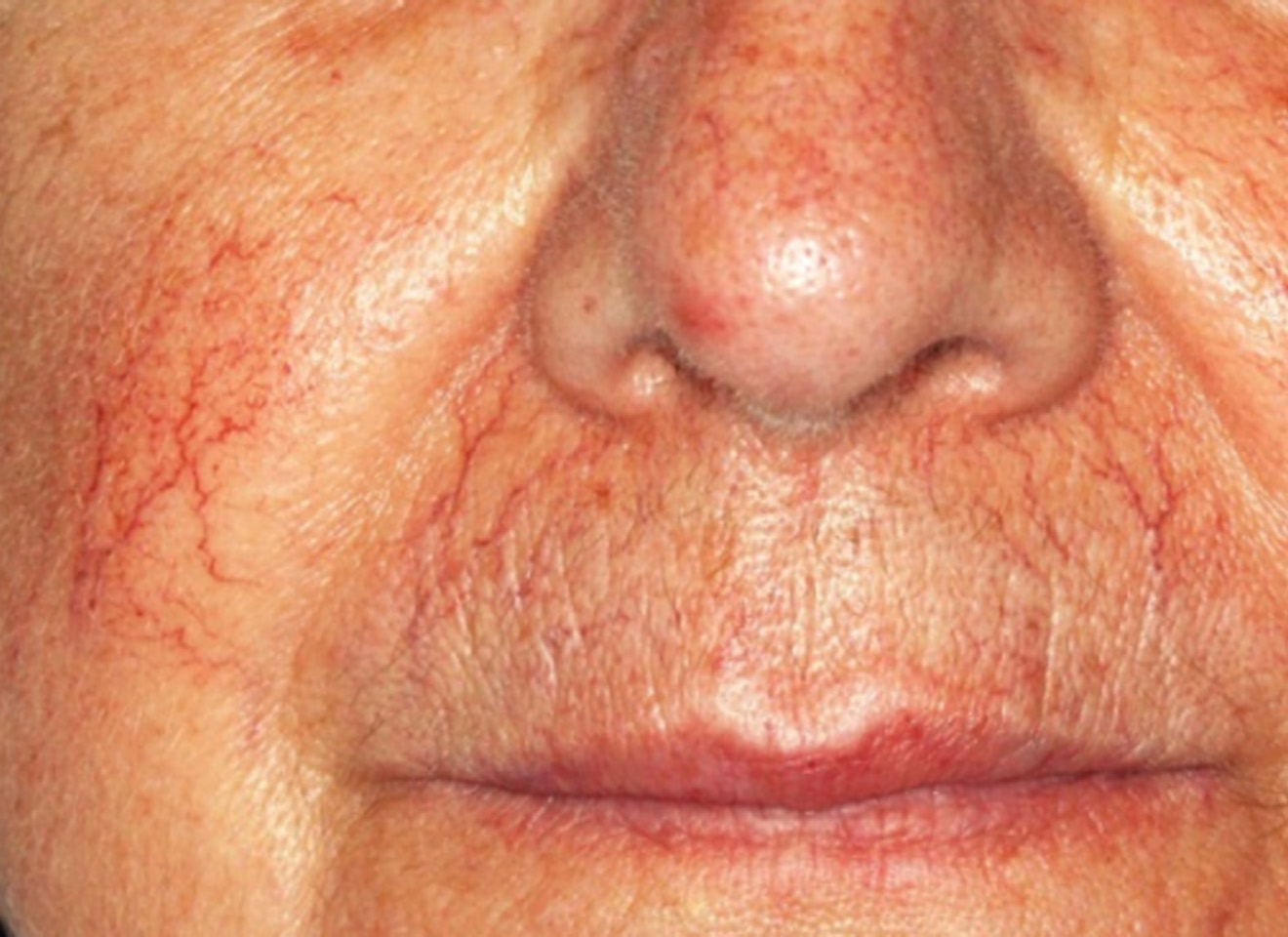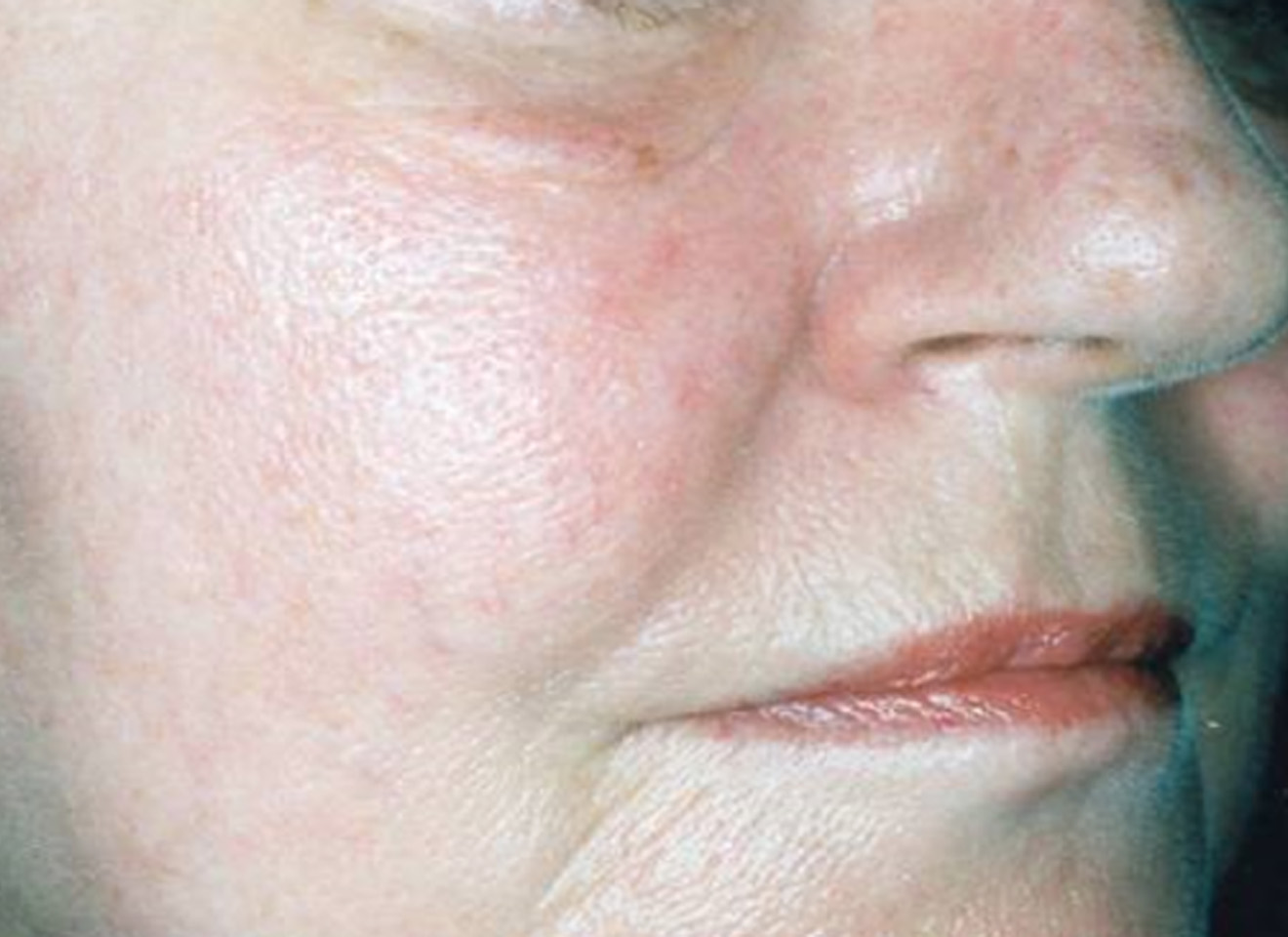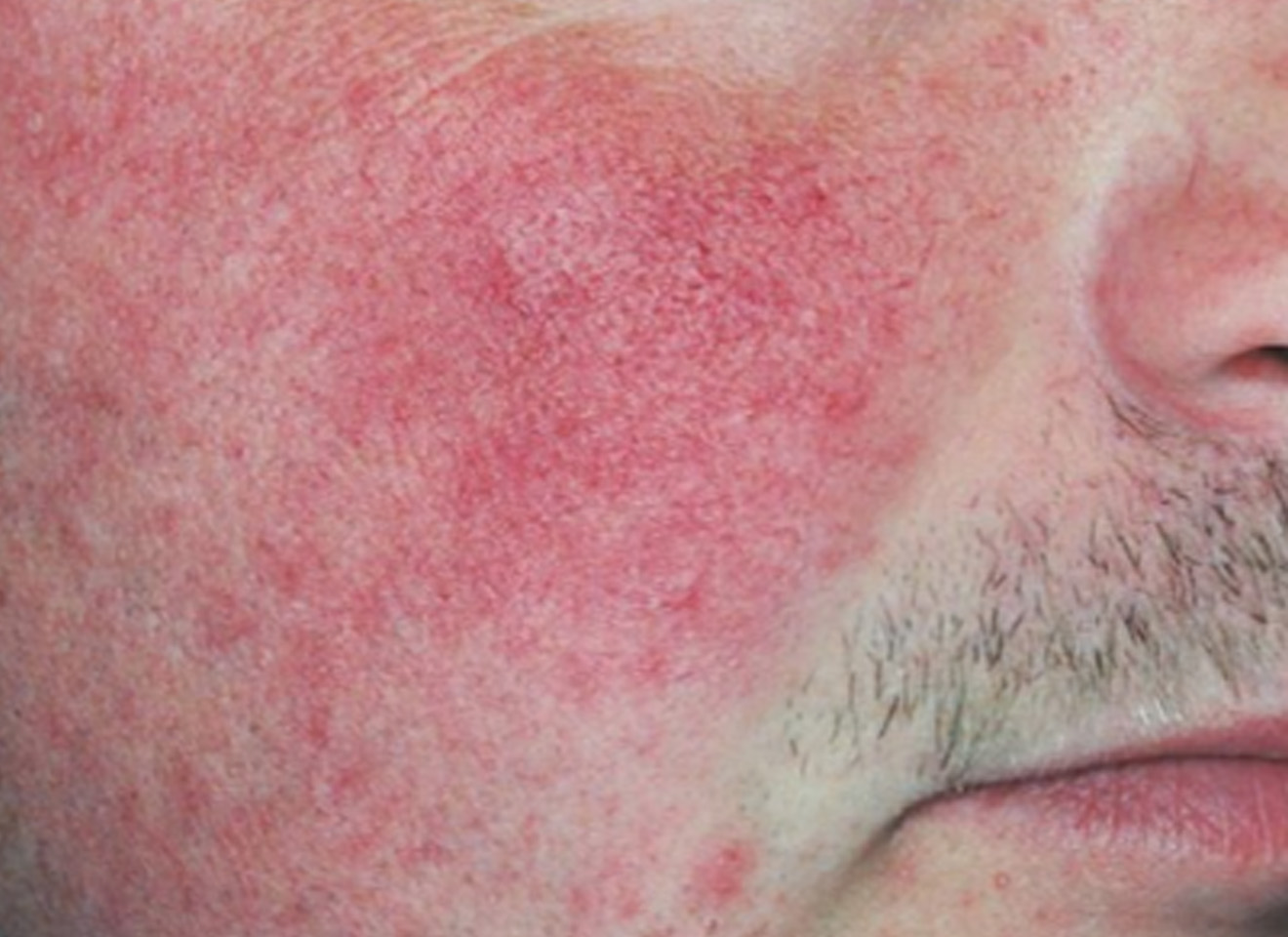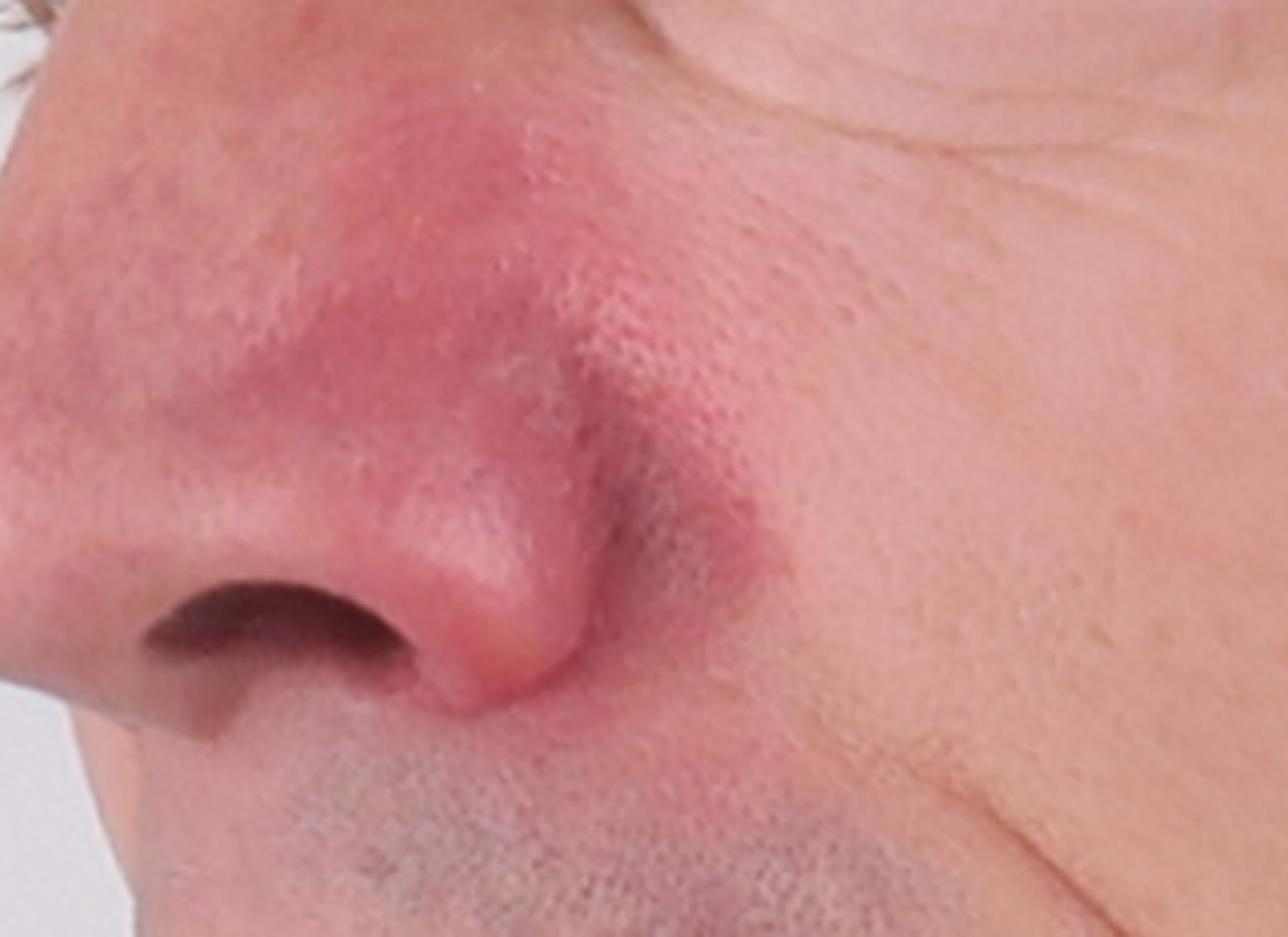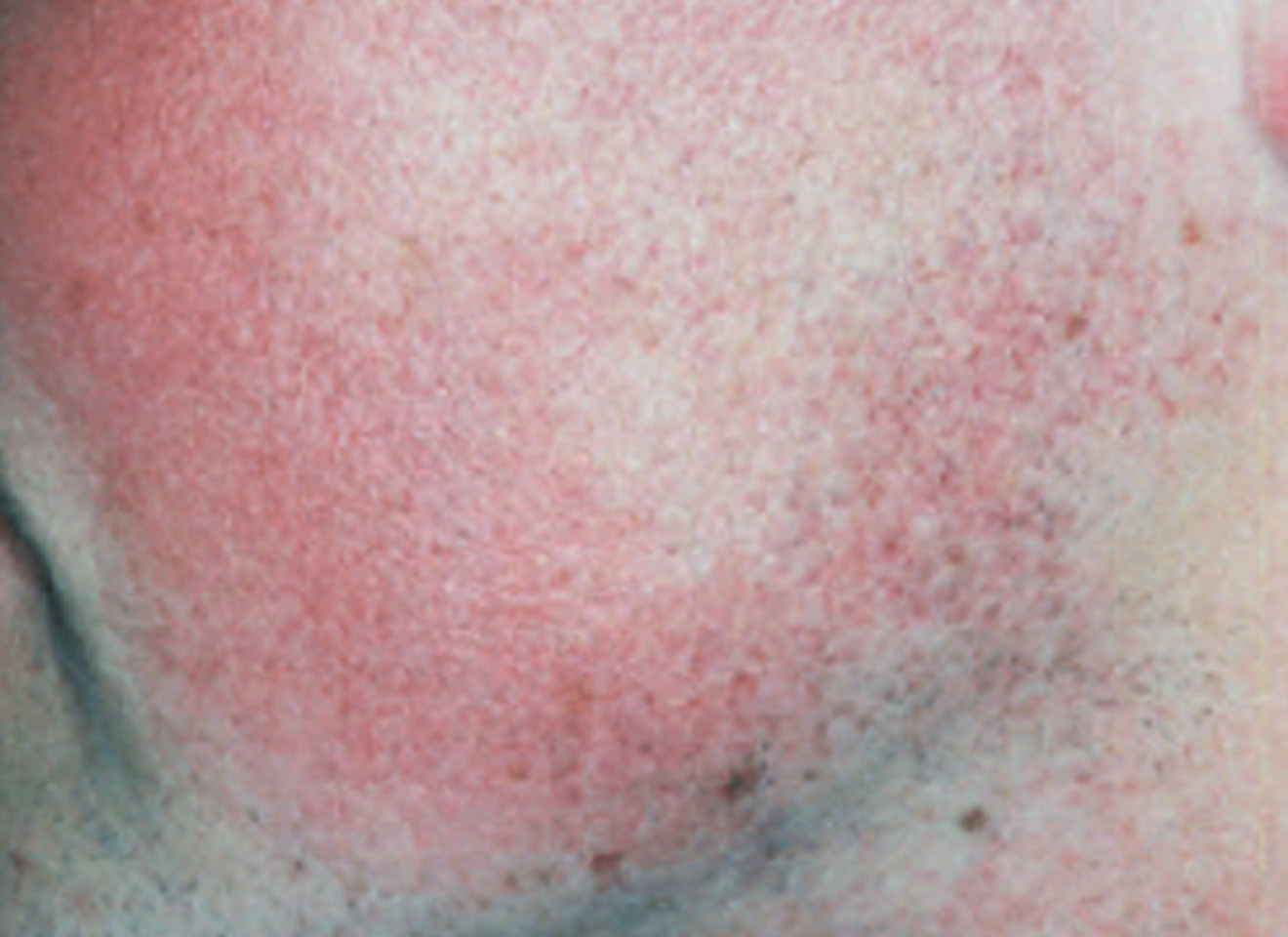Our Aesthetics and Laser Center, located on the Mulhouse-Saint-Louis axis near the city of Basel, specializes in the laser treatment of skin conditions such as erythrosis, rosacea and rosacea. With state-of-the-art laser technologies and a team of doctors who specialize in laser treatments, we offer you a personalized approach to reducing unwanted redness, dilated blood vessels, and rosacea symptoms. Our commitment to your comfort, safety, and visible results ensures you have an optimal treatment experience.
Facial redness
- The term facial redness is used when the skin becomes pink, red, bright red and sometimes even purple or bluish.
- Redness is due to excessive vasodilation of the blood vessels in a deeper layer of the skin, which is called the dermis, which is the vascularized part of the skin located under the epidermis.
- The redness can be localized (nose, cheeks, forehead, or chin) or diffuse and spread over the entire face.
- Depending on its origins, facial redness can be temporary , indicating hypersensitivity of the skin and last only a few moments or even a few days. But when redness persists or occurs more frequently, it is necessary to start worrying about it and treat it.
The psychological and relational consequences, the aesthetic damage, and the pejorative connotation conferred by a “red, a rubicund face” justify the request for medical and aesthetic care of the disease.
What are the causes of this redness?
Facial reddening: natural reaction and influencing factors
- Facial flushing can stem from a body’s natural response to intense emotions such as anger, excitement, or stress.
- It can also be triggered by a variety of behaviors and situations, such as exercise, allergic reactions, alcohol consumption, menopausal hot flashes, and even exposure to high temperatures.
- This normal reaction of the body is particularly pronounced in individuals with sensitive, fragile and/or reactive skin.
- Although redness can fade quickly on normal skin, it can persist longer (from a few hours to several days) on hypersensitive skin.
- These transient episodes of redness, commonly referred to as flushes or erythema, do not usually signal a skin disease.
Facial redness: meaning and clinical manifestations
- Facial redness can also be associated with various skin pathologies, of which Rosacea occupies a major place.
- Rosacea is a chronic facial dermatological condition characterized by recurrent flare-ups.
- Affecting about 2 to 3% of the adult population in France, it affects women more frequently (F/M ratio of about 2).
- This disease usually appears after the age of 20, peaking between the ages of 40 and 50, mainly in women with fair complexions. However, it is rare in children and becomes less common after a certain age (70 years).
- Sometimes, rosacea can manifest more severely in forms such as conjunctival rosaceas, hypertrophic forms, rhinophyma (more common in men), and facial pyoderma.
What is the difference between rosacea, erythrosis and rosacea?
Our aesthetic center, established in Mulhouse-Saint-Louis, offers you cutting-edge expertise in the laser treatment of skin conditions such as rosacea, rosacea and erythrosis. These terms are often used interchangeably, but it is important to understand their nuances. Rosacea is the “official” term for the disease, while rosacea is the dilation of blood vessels, a symptom of rosacea where the vessels are visible. In addition, erythrosis is manifested by a diffuse and constant redness of the skin. Thanks to our team of expert doctors and advanced laser technologies, we offer personalized solutions to alleviate these annoying symptoms and improve your skin well-being.
There are several subtypes of rosacea, including vascular forms (flushes and erythemato-telangiectasic), papulo-pustular forms and hypertrophic forms. Ophthalmological manifestations affect about 30 to 50% of patients with rosacea, in the form of dry eyes, conjunctivitis, blepharitis, photophobia, or even keratitis.
Vascular form of rosacea
It corresponds to paroxysmal vascular phenomena (flushes) or permanent vascular phenomena (erythemato-telangiectatic rosacea)
They result from the rapid and significant dilation of the cutaneous blood capillaries. These are flare-ups of paroxysmal redness of the face and neck, with a sensation of local heat, without systemic signs lasting a few minutes. These transient and natural reactions can aggravate rosacea.
The contributing factors are the following:
- Strong emotions, repeated stress or physical exertion
- Climatic factors: exposure to the sun, wind (especially cold wind) or cold.
- Temperature changes sometimes lead to thermophobia: working in front of heat sources, hot baths, saunas and hammams (any sudden thermal adaptation).
- Absorption of hot drinks and foods and spicy foods.
- Excessive and regular alcohol consumption significantly aggravates rosacea, and clearly accelerates the progression to erythrosis, rosacea and acne rosacea, sometimes severe, or even rhinophyma.
- A particular clinical form is corticosteroid-induced rosacea, often related to strong and prolonged local corticosteroid therapy on the face. It is characterized by a major dependence on corticosteroids, a dark red or even purplish desquamative erythema, and multiple telangiectasias. Unlike classic rosacea, the lesions can affect the perioral and/or periocular area.
- This is, by far, the most common form.
- The diagnosis is clinical: permanent centrofacial erythema in adults affecting the cheeks, nose, chin, central part of the forehead, disappearing on vitropressure is associated with telangiectasias that predominate on the sides of the nose and cheeks (rosacea).
- Edema (swelling) of the center of the face is sometimes visible. The skin may have a dry appearance with flaking.
- Ocular complications are common (30% to 50% of patients have subjective signs): dryness, conjunctivitis and blepharitis, or even keratitis.
has. Erythrosis
- Erythrosis is characterized by a diffuse and permanent redness.
- It affects the midfacial region: cheeks, nose, chin and the middle part of the forehead, sparing the area around the eyes and mouth. This location and the permanence of the redness are very typical of rosacea. It sometimes affects the hairless part of the scalp in balding men.
- In this form, the redness is accompanied by an exacerbated sensitivity of the skin which makes it difficult to apply cosmetics, sometimes even soap and water.
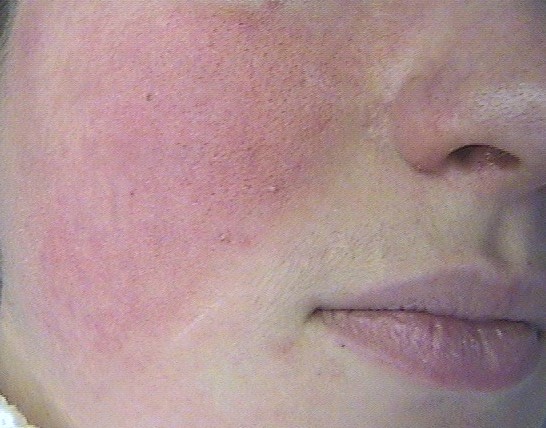
b. Rosacea
- The coloration of the skin can be associated with the development of small, very fine, well-individualized vessels on the surface of the skin, very red and sometimes even purplish defining rosacea. They are visible just below the surface of the skin and doctors refer to them as telangiectasias.
- Telangiectasias isolated from the wings of the nose are not a diagnostic criterion.
Papulopustalous form of rosacea
Long confused with acne, the old term “acne rosacea” must be abandoned. Inflammatory papules and pustules appear against a background of permanent erythema with the same topography
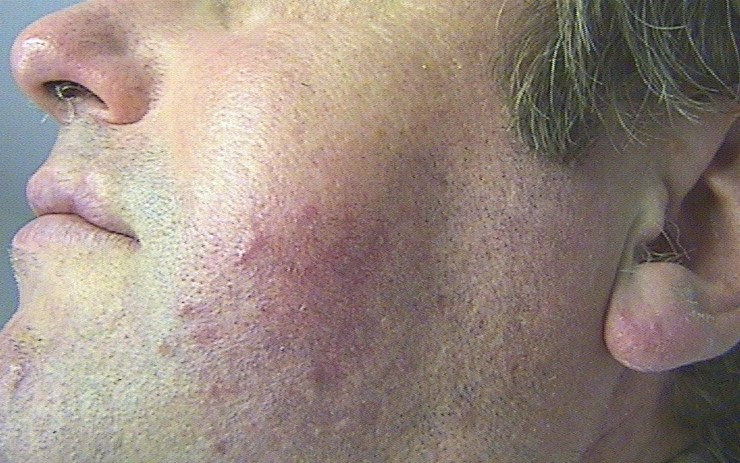
Papules are red, firm, and sometimes painful elevations of the skin that measure from one to four millimeters. They are surrounded by an inflammatory halo and can appear spontaneously against a background of redness in the center of the face.
Pustules are often smaller than papules, and can develop outside of any infectious context. These rashes evolve in flare-ups that usually improve spontaneously: the redness persists, but the pustular and papular lesions regress. If this is not the case, treatments can effectively help with the return to normal.

Hypertrophic form: rhinophyma
It mainly affects men (in more than 95% of cases), usually after the age of 50. The nose increases in volume, is diffusely red, with dilated follicular orifices. The skin gradually thickens, becomes fibrous and the nose takes on the classic “core” appearance, without alcohol being involved. The passage through these successive forms is not compulsory. Only surgical or CO2 laser treatment is effective.
What causes rosacea?
The mechanisms of occurrence of rosacea are, even today, quite mysterious and the cause of this disease is not known. Among the certainties of scientists:
Advanced treatment of rosacea, erythrosis and rosacea at the Mulhouse-Saint-Louis Medical Laser Center
“Explore the advanced solutions of our Mulhouse-Saint-Louis laser center, near Belfort and Montbéliard to effectively treat vascular conditions such as rosacea. Thanks to our vascular laser and pulsed light (IPL), we reduce the redness and telangiectasias characteristic of rosacea, while reducing the risk of recurrence. Recent technological advances strengthen our expertise in the successful management of rosacea and erythrosis.”
The light beam emitted from these devices is specifically absorbed by the hemoglobin present in the vessels. This light source of heat, of varying degrees, will cause the blood vessels to coagulate (photocoagulate) or destroy (purpura).
- The thermo-coagulation mode is a treatment that adapts well to mild rosacea. 3 or 4 sessions are usually necessary. The aftermath can be summarized as redness with a feeling of heating for a few hours.
- Photothermolysis is preferred for more severe forms of erythrocouperose. It is a more aggressive treatment since it causes the vessels to burst. However, it has the advantage of requiring fewer sessions: 1 to 2 sessions. Purplish purpurine spots (bruised or “bruised”) form that can last up to 3 weeks. Social eviction seems inevitable in this period. Purpura always disappears completely, passing through the different colors that we see after a bruise. Rarely, hyperpigmentation may persist for a few weeks, especially for dark, matte or mixed skin. This is why our team will offer you prior information, possible preparation, sun eviction and photo-protection in the weeks following the vascular laser treatment.
We will determine the choice of the most suitable technique based on the nature of your skin condition, its extent and your skin type.
Treatment modalities for rosacea and rosacea at the Mulhouse-Saint-Louis medical laser center: Essential Information
Local hygiene and rosacea/rosacea: advice for soothed skin at the Mulhouse-Saint-Louis centre
Rosacea is a chronic skin condition that can cause redness, visible blood vessels, and warm sensations on the face. Proper local hygiene can play a crucial role in managing this condition. Discover tips for maintaining soothed skin despite rosacea.
- 1. Clean gently: Use gentle cleansers without fragrance or harsh ingredients. Avoid excessive rubbing that could aggravate redness.
- 2. Avoid irritants: Opt for hypoallergenic and non-comedogenic skincare products. Avoid exfoliants, alcohols, and astringent toners.
- 3. Moisturize regularly: Use a moisturizer suitable for sensitive skin. Hydration helps strengthen the skin barrier and reduce irritation.
- 4. Sun protection: Apply a broad-spectrum sunscreen with a high SPF every day. Sun protection prevents rosacea triggers.
- 5. Gentle makeup: Use oil-free, non-comedogenic, makeup products that are specially formulated for sensitive skin. Avoid oily topicals and occlusive foundations;
- 6. Avoid heat sources: Limit exposure to hot water, steam baths, and saunas, which can trigger symptoms.
- 7. Balanced diet: Avoid spicy, hot foods and hot drinks, which can aggravate redness.
- 8. Stress Management: Stress can make rosacea worse. Practice relaxation and stress management techniques.
- 9. Consult a professional: Consult a dermatologist for a personalized treatment plan.
- 10. Topical corticosteroids are contraindicated. Artificial tears are beneficial in case of dry eyes.
By following proper local hygiene and avoiding triggers, you can help keep your skin calm and comfortable. If you need specific guidance for the treatment of rosacea or rosacea, the Mulhouse/Saint-Louis Medical Laser Center is here to help you.
Laser Treatment of Rosacea and Rosacea: long-lasting results in Mulhouse/Saint-Louis
The Mulhouse/Saint-Louis Medical Laser Center offers effective treatment for rosacea and rosacea, skin conditions related to dilated blood vessels and facial redness.
Advanced treatment for visible results
Our expert doctors offer laser treatment specifically designed to target the dilated blood vessels responsible for rosacea and rosacea. Small vessels may disappear immediately after treatment, while larger vessels gradually diminish over the following weeks.
Treatment duration and results
On average, 1 to 4 treatment sessions are necessary, spaced 1 month apart, depending on the severity of the lesions and the method chosen. With photothermolysis, blood vessels are targeted using precise light energy responsible for purpura, while photocoagulation can be performed without any real noticeable consequences.
Long-term management of rosacea
Being a chronic hereditary disease, rosacea may require maintenance sessions. The frequency of maintenance varies from one person to another, ranging from several months to several years, depending on the case.
Entrust your rosacea and rosacea treatment to the Mulhouse/Saint-Louis Medical Laser Center for visible results and long-term management of these skin conditions.
What are the indications for the treatment of these vascular lesions at the Mulhouse-Saint-Louis center?
- All familial or provoked rosacea in adults.
- Dermatological lesion located on the area of skin to be treated
- Tanned skin
- Phototypes V and VI
- Healing problems
- Treatment during pregnancy is not recommended
EXPLORE OUR SELECTION OF ARTICLES
Laser and IPL Rosacea Treatment in Aesthetic Medicine: Everything You Need to Know
